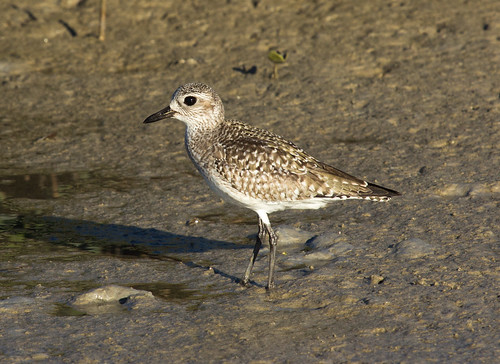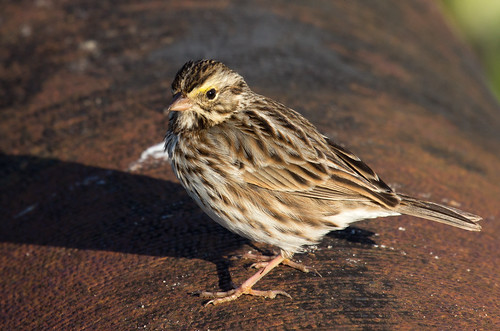
When I was a new birder in 1976, Russ and I spent a semester house-sitting for a professor in a rural area outside Lansing, Michigan. Behind his yard was a large open field bordered by trees and a lovely pond. This was where I witnessed my very first sky-dancing woodcocks, found my first Mourning Dove nest, and attracted a wide variety of songbirds at my very first bird feeder.
When I had to come up with a field research project for my ornithology class, I studied the most abundant bird in that field—the Savannah Sparrow. Hour after hour I watched them and listened to their quiet snore-like calls, and little by little I learned to distinguish individuals. That made mapping their territories fairly straightforward. I plotted out the field and then stood here and there, playing Savannah Sparrow songs on a tape recorder. The moment I started, several sparrows always piped in. When one flew up and sang assertively from a nearby perch, I knew that the spot I was standing in and the perches the bird was using were within his territory.

I spent so much time watching and listening and seeing what unique individuals each one was that I couldn’t help but fall in love. I lacked the skills and experience to do more than simply map territories, and in retrospect I missed a lot of exciting soap-opera drama.
It turns out that mated, ostensibly monogamous Savannah Sparrow females spend a lot of time checking out males throughout a large area, and visit more than one, in the conjugal sense, during the time they’re producing eggs. And about half of all males attract two females to their territory. In Bridget Stutchbury’s book, The Private Lives of Birds, she notes that one reasonable explanation might be that the female chooses a mate who is strong enough to defend a high quality territory, even if she has to share that territory with another female. Mixing it up genetically with some extra-pair hanky-panky ensures that baby Savannah Sparrows will be fitter.
Everyone knows that inbreeding can foster genetic abnormalities and problems. The more dissimilar the genes of a mated pair, the healthier their young will be. One of the most important families of immune system genes in every vertebrate is the “major histocompatibility complex,” or MHC. Stutchbury explains, “Each gene variant codes for a unique protein whose job it is to recognize and trap specific invading viruses and bacteria that are later killed by white blood cells. More types of MHC proteins manufactured by one’s DNA means that more types of invaders can be intercepted and stopped in their tracks before the infection gets serious. A nestling with genetically different parents will inherit more varieties of the MHC and so will have a stronger immune system.”
How do females judge a male’s genetic compatibility or dissimilarity? Females breed with multiple males and let their body figure it out. Many birds apparently have a physiological mechanism that gives genetically dissimilar sperm an advantage in surviving inside the oviduct!
Savannah Sparrows have been surviving for thousands of years by perfecting their complex mating systems. But early mowing threatens them. Stutchbury cites a Ph.D. student at the University of Vermont, who found that mowing hayfields in early June destroys virtually all the nests in the field at once, no matter what stage they were each at. Eggs and nestlings are all destroyed, forcing the females to begin renesting en masse. Mowing creates a uniform habitat, so the strongest birds no longer have an advantage in getting the best territories. After mowing, larger males no longer held better territories, each male could attract just one social mate, and mating outside the pair bond became rare. This early mowing destroys what Skutchbury calls the “delicate interplay of male competition for mates,” leads to lower genetic diversity, and drives population declines.
Savannah Sparrows aren’t on any lists of birds of conservation concern. The International Union for Conservation of Nature (IUCN) is the world’s oldest and largest global environmental organization. They list the Savannah Sparrow as a “species of least concern.” A lot of species are declining much more rapidly than they are. But the population is steadily dwindling, especially in Minnesota and Wisconsin, where mowing practices are changing. Breeding Bird Surveys show this decline. Fortunately, the decline is slow and this is a common species. I hope we can do what is necessary to keep the Savannah Sparrow that way.
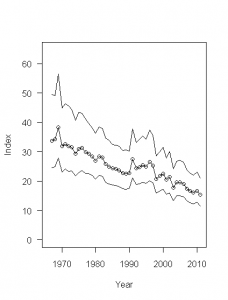
Savannah Sparrow Breeding Bird Survey data for Minnesota
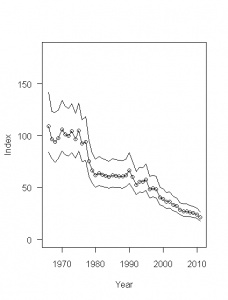
Savannah Sparrow Breeding Bird Survey data for Wisconsin
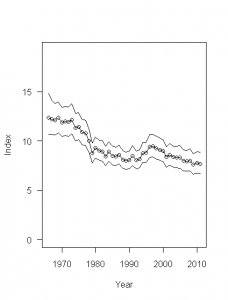
Savannah Sparrow Breeding Bird Survey data for entire United States
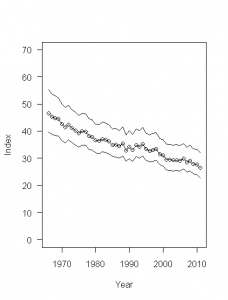
Savannah Sparrow Breeding Bird Survey data for Canada
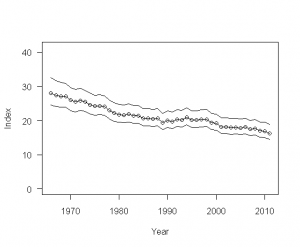
Savannah Sparrow Breeding Bird Survey data for entire Breeding Bird Survey

